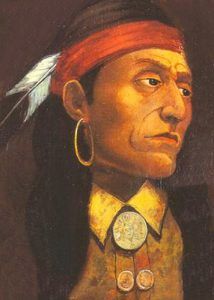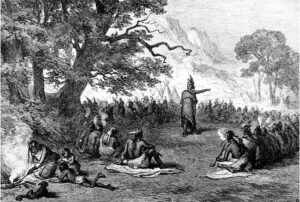 The pilgrims were not the only people who did not like, or accept, British rule. When the French sold some of their territory to the British, the Indian tribes in these areas were not happy about the new regime. The French had more or less left them alone to do as they chose, and so they tended to live in relative peace, but the British were a different kind of rule, and the Indians felt that they were far less conciliatory than their predecessors. It wasn’t that the French and the Indians got along well, after all they had just ended the French and Indian Wars in the early 1760s. It was simply that the British were more demanding and less giving in the area of the Indian rights, than the French had been.
The pilgrims were not the only people who did not like, or accept, British rule. When the French sold some of their territory to the British, the Indian tribes in these areas were not happy about the new regime. The French had more or less left them alone to do as they chose, and so they tended to live in relative peace, but the British were a different kind of rule, and the Indians felt that they were far less conciliatory than their predecessors. It wasn’t that the French and the Indians got along well, after all they had just ended the French and Indian Wars in the early 1760s. It was simply that the British were more demanding and less giving in the area of the Indian rights, than the French had been.
As the matter became more and more heated, an Ottawan Indian chief named Pontiac decided that it was time for the Indian tribes to rebel. So, he called together a confederacy of Native warriors to attack the British force at Detroit. In 1762, Pontiac enlisted support from practically every tribe from Lake Superior to the lower Mississippi for a joint campaign to expel the British from the formerly French-occupied lands. According to Pontiac’s plan, each tribe would seize the nearest fort and then join forces to wipe out the undefended settlements. In April 1763, Pontiac convened a war council on the banks of the Ecorse River near Detroit. It was decided that Pontiac and his warriors would gain access to the British fort at Detroit under the pretense of negotiating a peace treaty, giving them an opportunity to seize forcibly the arsenal there. However, British Major Henry Gladwin learned of the plot, and the British were ready when Pontiac arrived in early May 1763, and Pontiac was forced to begin a siege. His Indian allies in Pennsylvania began a siege of Fort Pitt, while other sympathetic tribes, such as the Delaware, the Shawnees, and the Seneca, prepared to move against various British forts and outposts in Michigan, New York, Pennsylvania, Maryland and Virginia, at the same time. After failing to take the fort in their initial assault, Pontiac’s forces, made up of Ottawas and reinforced by Wyandots, Ojibwas and Potawatamis, initiated a siege that would stretch into months.
A British relief expedition attacked Pontiac’s camp on July 31, 1763. They suffered heavy losses and were repelled in the Battle of Bloody Run. However, they did succeeded in providing the fort at Detroit with reinforcements and supplies. That victorious battle allowed the fort to hold out against the Indians into the fall. Also holding on were the major forts at Pitt and Niagara, but the united tribes captured eight other fortified posts. At these forts, the garrisons were wiped out, relief expeditions were repulsed, and nearby frontier settlements were destroyed.
Two British armies were sent out in the spring of 1764. One was sent into Pennsylvania and Ohio under Colonel Bouquet, and the other to the Great Lakes under Colonel John Bradstreet. Bouquet’s campaign met with success, and the Delawares and the Shawnees were forced to sue for peace, breaking Pontiac’s alliance. Failing to persuade tribes in the West to join his rebellion, and lacking the hoped-for support from the French, Pontiac finally signed a treaty with the British in 1766. In 1769, he was murdered by a Peoria tribesman while visiting Illinois. His death led to bitter warfare among the tribes, and the Peorias were nearly wiped out.


Leave a Reply